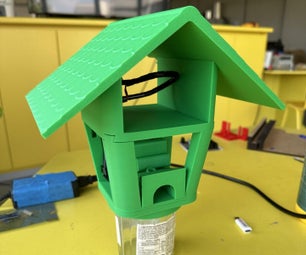Introduction: Small Strobe Light
Small strobe light using a 5W luxeon star.
Runs for over 2 hrs from a 9V battery, fits into a altoids gum tin.
A fun project that cost under $50 and takes under 2 hours.
you also get to claim bonus geek points when your electronics come with a warning like:
"WARNING! Luxeon LEDs are extremely bright! Looking directly into a into a lighted LED will cause eye damage! Use caution when working with these LEDs"
Runs for over 2 hrs from a 9V battery, fits into a altoids gum tin.
A fun project that cost under $50 and takes under 2 hours.
you also get to claim bonus geek points when your electronics come with a warning like:
"WARNING! Luxeon LEDs are extremely bright! Looking directly into a into a lighted LED will cause eye damage! Use caution when working with these LEDs"
Step 1: Components
The components I used:
Luxeon V star. The most powerful led available!
LED Dynamics Buck Puck, p/n 03021-D-I-1000 1A Wide range high output LED driver module
lm555 timer ic
8 pin socket for 555 ic
47µF 16V electrolytic capacitor
270 ohm variable resistor
270 ohm 1/4 watt carbon resistor (red purple brown)
9V battery snap
jumper wires
proto board with copper solder pads around each hole
heat sink from an old motherboard
two tiny nuts and bolts
Altoids gum tin
Tools:
Soldering iron w/ solder
diagonal cutters
utility knife (to cut proto board)
drill with bit same diameter as your tiny bolts
Luxeon V star. The most powerful led available!
LED Dynamics Buck Puck, p/n 03021-D-I-1000 1A Wide range high output LED driver module
lm555 timer ic
8 pin socket for 555 ic
47µF 16V electrolytic capacitor
270 ohm variable resistor
270 ohm 1/4 watt carbon resistor (red purple brown)
9V battery snap
jumper wires
proto board with copper solder pads around each hole
heat sink from an old motherboard
two tiny nuts and bolts
Altoids gum tin
Tools:
Soldering iron w/ solder
diagonal cutters
utility knife (to cut proto board)
drill with bit same diameter as your tiny bolts
Step 2: Build 555 Astable Multivibrator Circuit
I recommend breadboarding the entire circuit first. It was way easier on a breadboard that trying to figure out what goes where on a tiny piece of protoboard.
Start by building the 555 astable multivibrator circuit. I used a 270 ohm fixed resistor between pin 7 and Vcc and a 270 ohm variable resistor between pins 6 and 7
This circuit uses an RC time constant (see: http://en.wikipedia.org/wiki/RC_time_constant.) By changing the resistance between pins 6 and 7 or the size of the capacitor, you can control the rate of the strobe.
For the variable resistor, I used what I had handy. A 1K ohm variable will give you a greater strobe range.
Start by building the 555 astable multivibrator circuit. I used a 270 ohm fixed resistor between pin 7 and Vcc and a 270 ohm variable resistor between pins 6 and 7
This circuit uses an RC time constant (see: http://en.wikipedia.org/wiki/RC_time_constant.) By changing the resistance between pins 6 and 7 or the size of the capacitor, you can control the rate of the strobe.
For the variable resistor, I used what I had handy. A 1K ohm variable will give you a greater strobe range.
Step 3: Interface the Timer to the LED Driver
Next, interface your 555 timer circuit to the Buck Puck LED driver. This is easy. Just put a jumper wire from pin 3 of the 555 to the control pin of the Buck Puck.
I would wait to attach the Luxeon V to the driver yet. If you power it up, and it's not heatsinked, it can go into thermal runaway and melt itself down.
Note that the ref pin is not used.
I would wait to attach the Luxeon V to the driver yet. If you power it up, and it's not heatsinked, it can go into thermal runaway and melt itself down.
Note that the ref pin is not used.
Step 4: Prepare the Case (altoids Tin)
Next I drilled a couple of holes in my heatsink, and through the altoids tin and bolted the Luxeon star to the heatsink and to the lid of the tin.
Run the wires from the LED to the + and - on the Buck Puck, double check your circuit, and test it out!
Don't forget to snip a little hole in the side for the wires to come out.
Run the wires from the LED to the + and - on the Buck Puck, double check your circuit, and test it out!
Don't forget to snip a little hole in the side for the wires to come out.
Step 5: Put It in the Can
After you get the circuit working on a breadboard, transfer it over to a proto board. I used a dimension of 12x12 holes, with the corners rounded off to fit snug in the case. There is just enough room to fit the 9V in below it. That's it! Remember not to stare at it, or you'll go blind!
as an optional upgrade, I'm going to mount a microswitch in alongside the battery, and wire it in series so that when the lid is closed, the strobe comes on, and when you open it, it turns off.
Obviously there are more ways to skin this cat. I have been thinking about using several Luxeon III's spread out over a larger area to give a more dramatic effect. BTW, this was great inside my pumpkin.
as an optional upgrade, I'm going to mount a microswitch in alongside the battery, and wire it in series so that when the lid is closed, the strobe comes on, and when you open it, it turns off.
Obviously there are more ways to skin this cat. I have been thinking about using several Luxeon III's spread out over a larger area to give a more dramatic effect. BTW, this was great inside my pumpkin.







